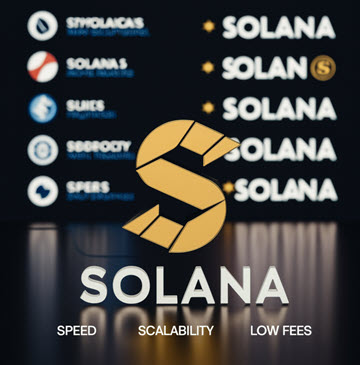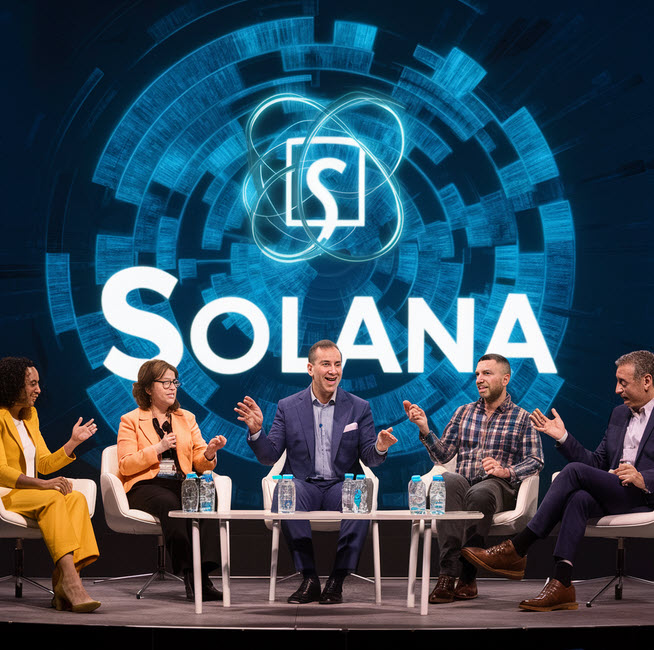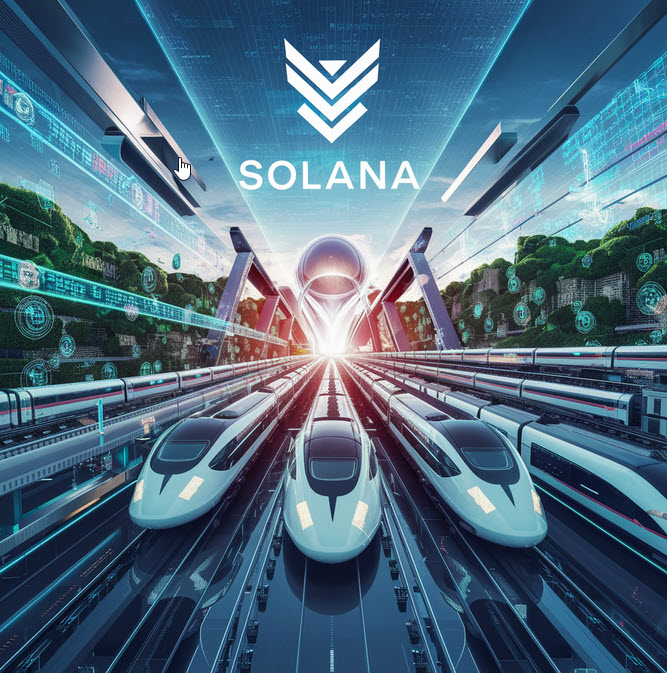Discover Solana: The Fast and Unique Blockchain Platform
Unleashing the Power of Solana – Blockchain Platform
Imagine transactions that happen in the blink of an eye, and fees are so tiny you barely notice them. Welcome to the world of Solana – Blockchain Platform! If you’re curious about what makes Solana stand out from other blockchains like Ethereum and Bitcoin, you’re in the right place.
What Makes Solana Different?

Speed and Efficiency
Solana is incredibly fast. It processes transactions in just 400 milliseconds! To put that in perspective, Ethereum takes about 10 seconds, and Bitcoin can take up to 10 minutes. Solana can handle around 710,000 transactions per second, much more than the 24,000 that Visa processes.
Low Costs
On Solana, transaction fees are incredibly low, about one-hundredth of a penny. This makes it very affordable for users and developers alike.
The Magic Behind Solana: Proof of History
What is Proof of History?
Solana uses a special technology called Proof of History (PoH). Think of it like a giant, super-fast clock that helps keep everyone on the same time. This means that computers on the network don’t need to spend a lot of time talking to each other to agree on the time. Instead, they can process transactions quickly and efficiently.
Parallel Processing with Sea Level
Solana also uses something called Sea Level, which lets it do many tasks at once. Imagine if you could wash the dishes, do your homework, and play a game all at the same time. That’s how Solana handles transactions, making it very powerful.
Who Created Solana?

Solana was created by a smart guy named Anatoly Yakovenko. He worked at a tech company called Qualcomm before starting Solana. The name “Solana” actually comes from a beach that Anatoly likes a lot.
Why Choose Solana?
No Big Requirements
Unlike other blockchains, you don’t need a lot of money to help validate transactions on Solana. You just need to hold a small amount of Solana coins and pay a fee.
Developer-Friendly
While Solana uses a powerful programming language called Rust, which can be a bit tricky, it gives developers a lot of control and power to create amazing apps.
The Heart of Solana: The Sol Coin
The main coin used in Solana is called Sol. It’s used to pay for transactions and other activities on the network. Solana has a smart way of handling these coins to make sure there are always enough to go around, but not too many to cause problems.
Q&A About Solana Blockchain and Ecosystem

- What is the Solana blockchain? The project started in 2017 and was officially launched by the Solana Foundation in March 2020, with its headquarters located in Geneva, Switzerland. Solana is a high-performance, scalable blockchain platform known for its fast transaction speeds and low fees. It supports a wide range of decentralized applications (dApps) and aims to provide an efficient and secure environment for users and developers.
- What is SOL cryptocurrency? SOL is the native cryptocurrency of the Solana blockchain. It’s used for transaction fees, staking, and participating in the platform’s governance.
- What is Proof of History (PoH)? Proof of History (PoH) is a unique consensus mechanism used by Solana. It integrates time into the blockchain data, allowing for faster transaction processing by eliminating the need for constant synchronization between nodes.
- Why is Solana considered a high-performance blockchain? Solana can process thousands of transactions per second due to its innovative technologies like PoH and Sea Level, a parallel processing system. This makes it one of the fastest blockchains available.
- How does Solana achieve scalability? Solana achieves scalability through its unique technologies and architecture, allowing it to handle a high volume of transactions without slowing down. This is crucial for supporting large-scale dApps and enterprise solutions.
- What is the Solana ecosystem? The Solana ecosystem includes a variety of projects, from decentralized finance (DeFi) applications to non-fungible tokens (NFTs) and more, all built on the Solana blockchain. It is supported by the Solana Foundation and a growing community of developers and users.
- What are decentralized applications (dApps) on Solana? Decentralized applications (dApps) on Solana are applications that run on the Solana blockchain, leveraging its speed and efficiency to provide services without central authority. Examples include DeFi platforms, NFT marketplaces, and gaming applications.
- What are Solana NFTs? Solana NFTs are non-fungible tokens that exist on the Solana blockchain. They benefit from Solana’s low transaction fees and high speed, making them a popular choice for creators and collectors.
- What are Solana smart contracts? Solana smart contracts are self-executing contracts with the terms of the agreement directly written into code. They are used to automate and enforce transactions and agreements on the Solana blockchain.
- What is a Solana wallet? A Solana wallet is a digital wallet used to store, send, and receive SOL and other tokens on the Solana blockchain. It also allows users to interact with dApps and participate in staking.
- What is Solana staking? Solana staking involves locking up SOL tokens to support the network’s security and operations. Stakers earn rewards in the form of additional SOL tokens.
- What is Solana DeFi? Solana DeFi (Decentralized Finance) refers to financial services built on the Solana blockchain, including lending, borrowing, trading, and earning interest, all without traditional intermediaries.
- What is Solana tokenization? Solana tokenization is the process of creating digital tokens on the Solana blockchain that represent real-world assets. This can include anything from stocks and real estate to art and intellectual property.
- What is a Solana validator? A Solana validator is a node in the Solana network that helps process transactions and secure the blockchain. Validators are crucial for maintaining the network’s integrity and performance.
- How fast is Solana’s transaction speed? Solana can process up to 710,000 transactions per second, making it one of the fastest blockchains in existence.
- What is Solana’s consensus mechanism? Solana uses a combination of Proof of History (PoH) and Proof of Stake (PoS) for its consensus mechanism, allowing for fast and secure transaction validation.
- What is the Solana Foundation? The Solana Foundation is a non-profit organization dedicated to the growth and development of the Solana blockchain and its ecosystem. It provides resources and support for projects building on Solana.
- What developer tools are available for Solana? Solana offers a range of developer tools, including APIs, SDKs, and frameworks, to help developers build and deploy applications on the Solana blockchain.
- How does Solana compare to Ethereum? Solana is often compared to Ethereum due to its high speed, low fees, and scalability. While Ethereum remains more widely adopted, Solana offers superior performance, making it an attractive alternative for developers and users.
- What is Solana’s market cap? Solana’s market cap fluctuates based on the value of the SOL token. It is one of the largest cryptocurrencies by market cap, reflecting its growing adoption and use.
- What are Solana’s price predictions? Solana price predictions vary widely, but many analysts believe it has significant growth potential due to its technological advantages and expanding ecosystem.
- Can you mine Solana? No, Solana does not use mining. Instead, it uses staking and a combination of PoH and PoS for transaction validation.
- What is Solana’s governance model? Solana’s governance involves the SOL token holders who can vote on proposals and changes to the network. This ensures the community has a say in the blockchain’s future direction.
- What are Solana’s major partnerships? Solana has partnered with various organizations and projects in the crypto and tech space, enhancing its ecosystem and expanding its reach.
- What is Solana’s adoption rate? Solana’s adoption rate is rapidly increasing, with more developers, projects, and users joining the ecosystem due to its performance and efficiency.
- What does the future hold for Solana? The future of Solana looks promising with ongoing technological advancements, increasing adoption, and a strong community backing its growth.
- What is Solana’s roadmap? Solana’s roadmap includes further scalability improvements, ecosystem expansion, and new features to enhance its blockchain and attract more users and developers.
- How secure is Solana? Solana is considered secure, with robust consensus mechanisms and regular updates to address vulnerabilities. However, as with any technology, continuous efforts are made to improve its security.
A Bright Future Ahead
Solana is still in its early stages, but it’s already showing how powerful and efficient a blockchain can be. Whether you’re interested in using it, investing in it, or building on it, Solana is definitely a platform to watch.
In conclusion, Solana – Blockchain Platform is revolutionizing the way we think about speed and efficiency in the blockchain world. Its unique technologies, such as Proof of History and Sea Level, set it apart from the rest. With its low costs, fast transactions, and user-friendly approach, Solana is paving the way for the future of blockchain technology. Keep an eye on this exciting platform as it continues to grow and innovate!
Do you own Solana? What’s your target price? Drop a comment below!

